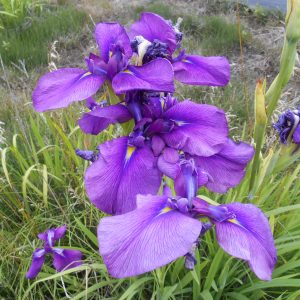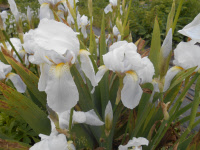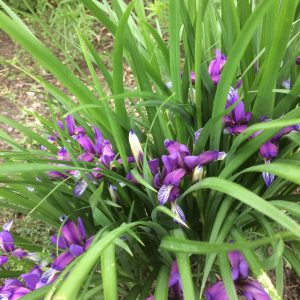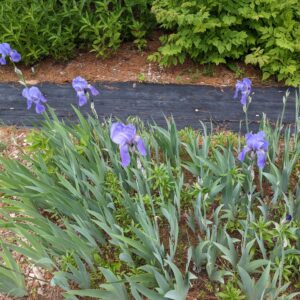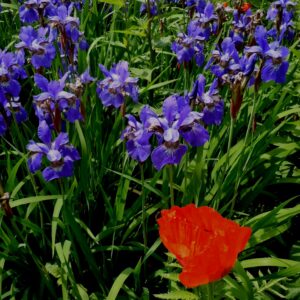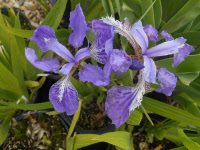Shop
Showing 433–440 of 785 results
-
Iris ensata syn. Iris kaempferi Japanese iris. Called Hana-shôbu in Japan Z. 5-8
White to reddish purple flowers with no beards (no standard, rising up) and have rhizomes all below ground.
ARCHIVED
Note: This is a plant not currently for sale. This is an archive page preserved for informational use.
White to reddish purple flowers with no beards (no standard, rising up) and have rhizomes all below ground.
Size: 2-3' x 9”
Care: moist acidic soil in full sun
Native: China, Korea and Japan
Wildlife Value: attracts hummingbirds, bees and butterflies. Deer and rabbit resistant.
Awards: England’s Royal Horticultural Society Award of Merit.Grown in Japanese gardens for at least 1200 years (since 8th century) as a marginal aquatic plant. A symbol for beautiful women and used to dye fabric. Introduced to the west in 1690’s by Englebert Kaempfer, physician to Dutch East India Co. on Deschema Island, off the coast of Japan. “The Garden” May 20, 1876: “For many of the siebold, German botanist (most beautiful varieties we are indebted to Dr. von Siebold, the celebrated German botanist, at Leyden.” Von Siebold (1796-1866).
-
Iris florentina Florentine iris, White flag Z 3-9
Sweetly fragrant, tall, icy blue-white iris with pale yellow signal on the fall, flowering in June
Sweetly fragrant, tall, icy blue-white iris with pale yellow signal on the fall, flowering in June
Size: 24-30” x 18-24”
Care: sun in moist well-drained soil. Plant with rhizome tops above soil.
Native: Italy and southern France
Wildlife Value: welcomes bees with easy access to pollenIris is named after the Greek goddess who accompanied the souls of women to the Elysian fields by way of the rainbow. Her footprints left flowers the colors of the rainbow. Iris means “eye of heaven.” The iris is the flower of chivalry, having “a sword for its leaf and a lily for its heart.” Ruskin. At least 2000 years old, this was identified by Dioscorides in De Materica Medica for medicinal use around 70 A.D. English herbalist John Gerard grew it by 1596. Grown in the Eichstätt Garden, the garden of Johann Konrad von Gemmingen, prince bishop of Eichstätt in Bavaria, c. 1600. Grown at America’s 1st botanic garden, Elgin Botanic Garden 1811. Its rhizome is the source of dried orris root. Dig in late summer, peel, chop, dry, age, and then grind into a powder which is a scent fixative for perfumes and potpourris and flavoring for Chianti wine. Orris root has a violet-like aroma. Add powder directly to potpourris. Mix with oil prior to adding to perfumes.
-
Iris graminea Grass-leaved iris, Plum-scented iris Z 4-8
Charming beardless spuria iris of purple styles, violet falls and ivory hafts with purple veins, blooming in June below the top of its grass-like foliage
Charming beardless spuria iris of purple styles, violet falls and ivory hafts with purple veins, blooming in June below the top of its grass-like foliage
Size: 9-16” x 9-16”
Care: sun to part shade in moist well-drained soil
Native: from Spain to Russia & Caucasus in Asia. But now endangered in Czechoslovakia and extinct in Germany.
Wildlife Value: attracts hummingbirds, bees, and butterflies. Deer and rabbit resistant.
Awards: Royal Horticultural Society Award of Garden Merit.Graminea means grass. Common name of Plum-scented for its fruity, plum fragrance. In gardens since at least 1568. Planted at Cambridge Botanic Garden in 1733.
-
Iris missouriensis Western blue flag, Rocky Mountain iris Z 3-8
In spring variegated, violet blue iris flowers - 6 perianth segments, 3 spreading to reflexed falls with a dark yellow-orange stripe down the middle with blue lines on a white background, & 3 purple standards.
In spring variegated, violet blue iris flowers – 6 perianth segments, 3 spreading to reflexed falls with a dark yellow-orange stripe down the middle with blue lines on a white background, & 3 purple standards.
Size: 12-24” x 9-12”
Care: sun to part shade in moist well-drained to moist soil. Divide regularly.
Native: Alberta and British Columbia, from Minnesota to Washington south to California east to New Mexico
Wildlife Value: Deer resistant. Attracts hummingbirds, provides pollen to bees.Named for the Missouri River although ironically Lewis collected it along the Blackfoot River in today’s Montana on July 5, 1806.
Paiute Indians of eastern California and southeastern Oregon made ear drops to remedy earaches with a decoction if the Iris roots. -
Iris pallida Grape iris Z 3-8
Blooms smell exactly like sweet grape soda - violet blue bearded iris in spring
Blooms smell exactly like sweet grape soda – violet blue bearded iris in spring
Size: 10-14” x 8-12”
Care: sun to part shade in moist well-drained soil. In July-August lift & divide every 2 to 3 years; discard mushy rhizomes.
Native: Europe
Wildlife Value: Deer and rabbit resistant.English herbalist John Gerard (1549-1612) called it “the great Floure de-luce of Dalmatia” and praising its “exceedingly sweet” scent, 1597. Grape soda had yet to be created.! Was this the soda’s inspiration? Dried rhizomes used as a fixative to preserve fragrances in powders, perfume, and gin. Peel off outer skin of rhizomes and dry tor up to five years for this.
-
Iris pumila Dwarf iris Z4-8
Natural hybrid created this tiny, purple bearded iris blooming in early spring bearing year-long green-grey sword-shaped leaves. Spreads to form large, tight clumps.
Natural hybrid created this tiny, purple bearded iris blooming in early spring bearing year-long green-grey sword-shaped leaves. Spreads to form large, tight clumps.
Size: 6-8” x spreading.
Care: sun in well-drained to moist well-drained soil
Native: Eastern Europe
Wildlife Value: deer resistantIn gardens before 1753
-
Iris siberica Siberian Iris Z 4-9
sword shaped leaves with blue, purple or lilac Iris flowers
Narrow, sword shaped leaves with blue, purple, or white Iris flowers in June.
Size: 3-4' x S 12" and spreading
Care: Full sun moist well-drained soil. Deer resistant, Walnut toxicity resistant and drought tolerant.
Native: Eastern Siberia
Awards: England's Royal Horticultural Society Award of Merit.Iris is named after the Greek goddess who accompanied the souls of women to the Elysian Fields by way of the rainbow. Her footprints left flowers the colors of the rainbow. Iris means the “eye of heaven.” The iris is the flower of chivalry, having “a sword for its leaf and a lily for its heart.” Ruskin. Siberian Irises first cultivated in European gardens in the 1500’s. Blue Siberian Iris was introduced to the U.S. in 1796. Cultivated by Washington at Mount Vernon.
-
Iris tectorum Japanese roof iris, Wall iris, Root iris Z 5-9
In late spring violet flowers, with purple highlights, bloom above the flat, low fans of wide leaves
ARCHIVED
Note: This is a plant not currently for sale. This is an archive page preserved for informational use.
In late spring violet flowers, with purple highlights, bloom above the flat, low fans of wide leaves. It spreads into dense clumps. Rhizomes are poisonous.
Size: 12-14” X 3’
Care: sun to part shade in moist well-drained to well-drained soil
Native: Japan & Central & SW ChinaFor Japanese, a triple hitter. Women powdered rhizomes for their faces. Since at least the 7th century, Japanese grew this on their thatched roofs. It helped hold the thatching together. Folk lore also claimed it warded off evil spirits. 1st described for the West in 1871, Bulletin de l’Academie Imperiale des Sciences de St-Petersbourg.

